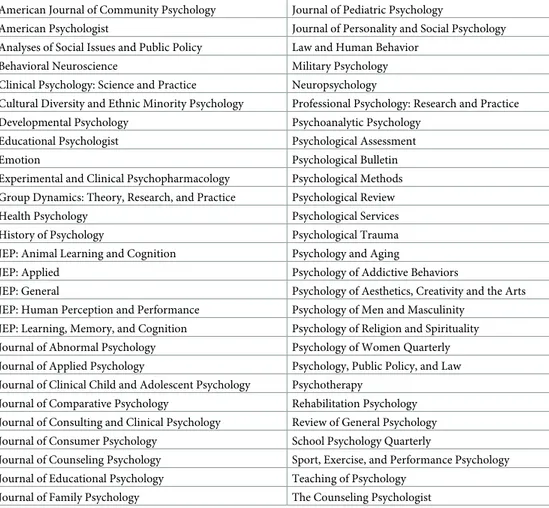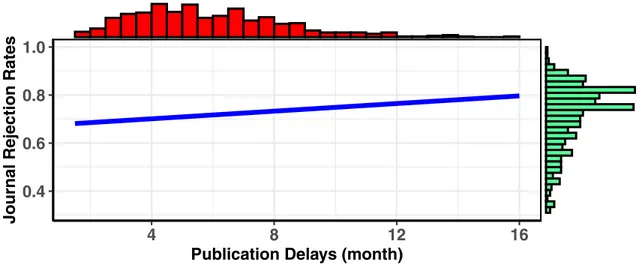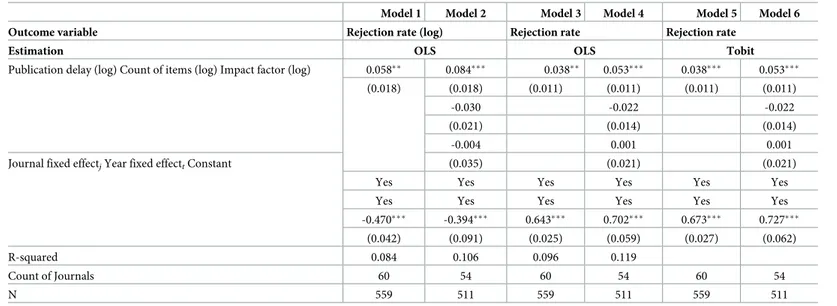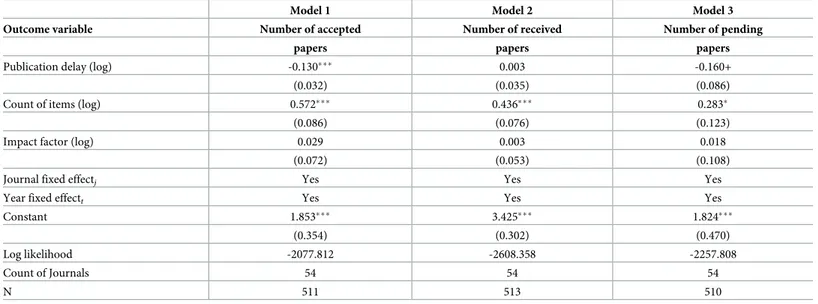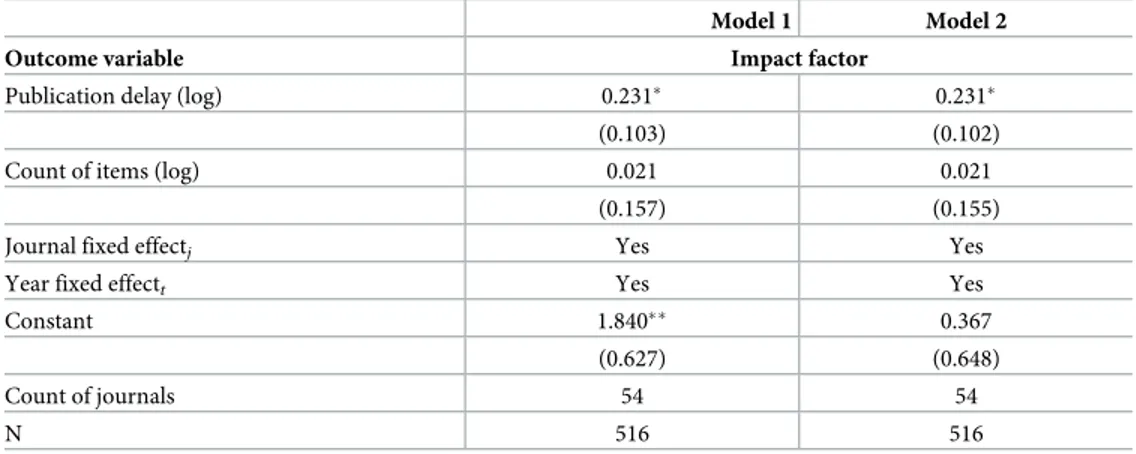RESEARCH ARTICLE
Does the pressure to fill journal quotas bias
evaluation?: Evidence from publication delays
and rejection rates
Brian ParkID1*, Eunhee Sohn2, Soohun Kim3
1 Department of Managerial Sciences, J. Mack Robinson College of Business, Georgia State University,
Atlanta, Georgia, United States of America, 2 Strategy and Innovation Area, Scheller College of Business, Georgia Institute of Technology, Atlanta, Georgia, United States of America, 3 Finance Area, KAIST College of Business, Korea Advanced Institute of Science and Technology, Seoul, Republic of Korea
*bpark@gsu.edu
Abstract
Although the peer review system of academic journals is seen as fundamental to scientific achievement, a major threat to the validity of the system is a potential evaluation bias result-ing from constraints at the journal level. In this study, we examine how the time pressure to maintain a fixed periodical quota for journal publication can influence a journal editor’s deci-sion to accept or reject a paper at any given point in time. We find that an increase in publica-tion backlog, proxied as the average delay between paper acceptance and print publicapublica-tion, is correlated with an increase in the subsequent rejection rates of new submissions. Our findings suggest that time pressures inherent in the peer review system may be a source of potential evaluator bias, calling for a need to reconsider the current quota system.
Introduction
Modern scientific research blossoms in the form of publications. Today’s peer review process serves as the backbone of modern science, resting on the postulate that publication validates the quality of scientific research [1–3]. Indeed, the idealized view of academic researchers is that submitted manuscripts are assessed by impartial evaluators based purely on manuscript quality, which is proportional to the likelihood of publication [3–5]. Anecdotal evidence sug-gests, however, that the academic journal review process persistently reflects errors in its acceptance of mediocre papers [6,7] and its rejection of seminal research for publication [8,
9]. Furthermore, these systematic errors may be attributed at least partially to administrative constraints that affect the selection process [10–12].
Given that most academic journals take the form of printed periodicals with fixed paper quotas published at regular time intervals (e.g., weekly, monthly, quarterly, yearly), editors are expected to accept a consistent number of papers for publication at each interval. Editors, who have been called the “gatekeepers of science” [1,13], wish to obtain high-quality papers and evaluate submitted manuscripts based purely on quality. However, their manuscript evaluation is also subject to the pressure to find a sufficient number of papers in time for the next regular
a1111111111 a1111111111 a1111111111 a1111111111 a1111111111 OPEN ACCESS
Citation: Park B, Sohn E, Kim S (2020) Does the pressure to fill journal quotas bias evaluation?: Evidence from publication delays and rejection rates. PLoS ONE 15(8): e0236927.https://doi.org/ 10.1371/journal.pone.0236927
Editor: Sergio A. Useche, Universitat de Valencia, SPAIN
Received: September 13, 2019 Accepted: July 17, 2020 Published: August 11, 2020
Peer Review History: PLOS recognizes the benefits of transparency in the peer review process; therefore, we enable the publication of all of the content of peer review and author responses alongside final, published articles. The editorial history of this article is available here:
https://doi.org/10.1371/journal.pone.0236927
Copyright:© 2020 Park et al. This is an open access article distributed under the terms of the
Creative Commons Attribution License, which permits unrestricted use, distribution, and reproduction in any medium, provided the original author and source are credited.
Data Availability Statement: All the APA journal data are available from the website;https://www. apa.org/pubs/journals/statistics.
Funding: The author(s) received no specific funding for this work.
issue. Thus, if an editor has a predetermined paper quota and an insufficient number of accepted papers for the next issue, the pressure to find new papers to fill that quota may over-ride the objective of maximizing the quality of the accepted papers.
In this study, we examine how such time pressures may have an unintended impact on the editor’s acceptance decisions for submissions. We empirically proxy the number of accepted but not yet published papers using the publication delay between paper acceptance and publi-cation in print. Our analysis provides evidence that when the number of accepted but not yet published papers is sufficient to meet the quota for the next regular issues of the print journal, editors are more likely to reject submissions because the pressure to meet the quota within a given time is low.
Time pressure is a ubiquitous phenomenon in our world. Our daily decision making in contexts such as stock trading, shopping, and job searching occurs within limited time con-straints that often press us to make quick decisions [14]. A number of researchers in the social sciences provide ample evidence that time pressure plays a significant role in decision making processes and risk-taking behavior. The existing literature documents how time pressure leads to increased risk aversion to losses [15,16] and reductions in the impact of product recom-mendations on consumer choices [17]. Some economists studying the effect of time pressure on successful bargaining have found that a high percentage of agreements are reached very close to the deadline [18]. Others have demonstrated the opposite effect in an ultimatum game, such that subjects are more likely to reject an offer under time pressure [19].
Like those in many contexts, then, editors of academic journals are constantly exposed to time pressure as they must meet their quota for quality papers at regular intervals. If editors fail in this task, they may be viewed by the editorial board, associate editors, and authors as performing poorly, and in some cases, be subject to penalties. Such pressure is likely to be aug-mented when editors find themselves short of accepted papers for the next regular issues of their journal, a situation in which they may consider accepting papers of less quality that might otherwise be rejected. When editors are subject to less time pressure, however, they may increase their quality threshold for incoming papers and eventually reject even high-quality papers that would have been accepted had they been submitted at a different time.
Model
Based on recent literature on time pressure and task quality, we developed a mathematical model to specify how an editor’s quality threshold for paper acceptance varies according to time pressure, a proxy for which is the backlog of accepted, yet unpublished, papers. The model assumes that an editor seeks to maximize the aggregate quality of papers in a journal according to the constraints of a fixed paper quota while papers of random quality are submit-ted to the journal at a constant probability. In fact, under such constraints, the greater the number of papers accepted, yet waiting to be published, the lower the possibility for a subse-quently submitted paper of equal quality to be accepted. In the formal descriptions of the model that follow, the editor accepts, at most,K papers for a journal that needs to be published at calendar timeT. The goal of the editor is to maximize the aggregate quality of papers in the journal. Att 2 [0, T], the editor receives a paper with the arrival rate of λ. The distribution of paper quality is known to followF (q), which does not depend on t. If a paper with the quality q arrives at time t, the editor accepts or rejects the paper based on the given quality of the paper. Letk denote the number of papers which are already accepted. The editor needs to select (k + 1)-th paper for the journal. We are interested in the effect of k, the number of pre-publication accepted papers, on the editor’s time pressure and on the probability of rejection of a received paper, which is a candidate for the (k + 1)-th paper.
Competing interests: The authors have declared that no competing interests exist.
Proposition 1.When k0>k, q (k0,t) � q (k, t).
It is worth highlighting that this proposition directly confirms our main argument because q(k + 1, t) � q(k, t) implies that the probability of acceptance for the (k + 1)-th paper is lower than that ofk-th paper because Pr (q > q(k + 1, t)) � Pr (q > q(k, t)), which implies that the editor’s quality threshold for manuscript acceptance changes according to time pressure, which is measured by the number of accepted papers. The details for the proof of the proposi-tion is included in ourS1 Appendix.
Materials and methods
We empirically tested our argument using the 2004–2017 annual publication data for 54 jour-nals affiliated with the American Psychological Association (APA) (Table 1). All these journals disclose complete information on the rejection rates, annual number of received/accepted/ pending papers, and number of items published in print (summary statistics and histograms are displayed inTable 2andFig 1, respectively). While the data does not reveal the average number of publication backlogsper se in a given year, the data instead provides the average publication delay of a given year in months, that is, the average difference in months between the dates of final paper acceptance and publication in print. We used this delay measure as a proxy for the backlog of accepted, but not formally published, papers (these are often referred to as forthcoming or in-press papers and do not have volume and issue information assigned).
Table 1. Journal list.
American Journal of Community Psychology Journal of Pediatric Psychology
American Psychologist Journal of Personality and Social Psychology
Analyses of Social Issues and Public Policy Law and Human Behavior
Behavioral Neuroscience Military Psychology
Clinical Psychology: Science and Practice Neuropsychology
Cultural Diversity and Ethnic Minority Psychology Professional Psychology: Research and Practice
Developmental Psychology Psychoanalytic Psychology
Educational Psychologist Psychological Assessment
Emotion Psychological Bulletin
Experimental and Clinical Psychopharmacology Psychological Methods Group Dynamics: Theory, Research, and Practice Psychological Review
Health Psychology Psychological Services
History of Psychology Psychological Trauma
JEP: Animal Learning and Cognition Psychology and Aging
JEP: Applied Psychology of Addictive Behaviors
JEP: General Psychology of Aesthetics, Creativity and the Arts
JEP: Human Perception and Performance Psychology of Men and Masculinity JEP: Learning, Memory, and Cognition Psychology of Religion and Spirituality
Journal of Abnormal Psychology Psychology of Women Quarterly
Journal of Applied Psychology Psychology, Public Policy, and Law
Journal of Clinical Child and Adolescent Psychology Psychotherapy
Journal of Comparative Psychology Rehabilitation Psychology Journal of Consulting and Clinical Psychology Review of General Psychology
Journal of Consumer Psychology School Psychology Quarterly
Journal of Counseling Psychology Sport, Exercise, and Performance Psychology
Journal of Educational Psychology Teaching of Psychology
Journal of Family Psychology The Counseling Psychologist
Then, we empirically examined the relationship between publication delays and rejection rates.
In most disciplines only a very small number of manuscripts is accepted for publication on the first submission, and most editors solicit at least one revision from authors. To capture the average review time for APA journals, we randomly selected five papers per publication year from each of APA-affiliated journals, all of which disclosed the specific dates of the first sub-mission and subsequent acceptance for each paper from 2004 through 2017. The average review time was 285 days and the standard deviation was 195.41 days, ranging from a few months to more than two years. Given that the review process period of most of the submitted manuscripts was shorter than two years (less than 730 days), we averaged the publication delays at one and two years prior to the focal year, took the logarithm, and used it as our explanatory variable to see its effect on rejection rate in yeart.
The reasoning behind this operationalization is that journals usually report their rejection rate in yeart as 1 minus acceptance rate, which is the number of accepted papers in year t divided by the number of received papers in yeart. This means that most of the rejections that
Table 2. Summary statistics.
Mean s.d. Min Max
Rejection rates 0.717 0.132 0.310 1.000
Publication delay (log) 1.708 0.429 0.405 2.773
Number of papers accepted 70.012 41.136 4 240
Number of papers received 311.462 230.842 47 1101
Number of papers pending 75.917 69.169 0 482
Count of items (log) 4.137 0.588 1.946 5.533
Journal impact factor (log) 0.781 0.702 -1.737 2.808
https://doi.org/10.1371/journal.pone.0236927.t002
Fig 1. Histograms of the key variables.
occur during the review process, which takes up to two years on average, donot immediately factor into the acceptance/rejection rate of the same year. Let us assume that during an evalua-tion process, an editor rejects a paper submitted in yeart-1 or year t-2 based on the publication delay of that year. This decision would, in effect, affect the rejection rate of yeart, given that the counterfactual final acceptance would have occurred in yeart. Although the 54 APA-affili-ated journals in question reported their rejection rates, each academic journal used a different method for calculating the rate. Therefore, for a robustness check, we also tested the extent to which publication delays affect the absolute number of accepted papers. We included two key variables as controls in our analysis. One is the count of items published in print (log) because it indicates the capacity for printed papers of each journal, and the other is the journal impact factor without self citations (log) drawn from Thomson Reuters, since high-quality journal editors may be less concerned about publication delays. Lastly, we included in the model fixed effect dummy variables for journal and year.
Results
Prior to the main analysis, we plotted the relationship between rejection rate and publication delay (Fig 2). The least-square fitted line in this figure shows that rejection rate is positively associated with publication delay, though a caveat is needed, as this estimation fails to consider the control variables and the fixed effects. Showing the least-square line, however, helps us cap-ture the relationship between the two variables in an illustrative manner. In our main analysis, ordinary least squares (OLS) regression with the control variables, as well as year/journal fixed effects, indicates a positive relationship between publication delay and subsequent rejection rate (seeFig 3; a plot of the coefficients of Model 2 inTable 3) regardless of the control vari-ables (Models 1 and 2 inTable 3).
The log–log regression coefficient estimates showed that a 1% increase in a journal’s publi-cation delay is correlated with about a 0.1% increase in the journal’s rejection rate, holding
Fig 2. Visualization of publication delays and rejection rates in APA-affiliated journals.
Fig 3. A plot of the coefficients in the main model (Model 2 inTable 3).
https://doi.org/10.1371/journal.pone.0236927.g003
Table 3. The effect of publication delay on APA rejection rates.
Model 1 Model 2 Model 3 Model 4 Model 5 Model 6
Outcome variable Rejection rate (log) Rejection rate Rejection rate
Estimation OLS OLS Tobit
Publication delay (log) Count of items (log) Impact factor (log) 0.058�� 0.084��� 0.038�� 0.053��� 0.038��� 0.053���
(0.018) (0.018) (0.011) (0.011) (0.011) (0.011)
-0.030 -0.022 -0.022
(0.021) (0.014) (0.014)
-0.004 0.001 0.001
Journal fixed effectjYear fixed effecttConstant (0.035) (0.021) (0.021)
Yes Yes Yes Yes Yes Yes
Yes Yes Yes Yes Yes Yes
-0.470��� -0.394��� 0.643��� 0.702��� 0.673��� 0.727���
(0.042) (0.091) (0.025) (0.059) (0.027) (0.062)
R-squared 0.084 0.106 0.096 0.119
Count of Journals 60 54 60 54 60 54
N 559 511 559 511 559 511
Coefficients are reported with robust standard errors clustered by each journal in parentheses. All models include journal and year fixed effects.
+ p<0.10, �p<0.05, ��p<0.01, ���p<0.001. https://doi.org/10.1371/journal.pone.0236927.t003
other variables constant. We also used the absolute number of accepted papers (log) as our outcome variable. The finding holds with the log of the number of accepted papers as our out-come variable (Model 1 inTable 4); publication delay is negatively associated with the subse-quent number of accepted papers. Critics may argue that authors can strategically change their submission time by considering their target journal’s publication delay. If this argument is true, we should find a relationship between the number of received papers and publication delay. We did not, however, find any significant impact of publication delay on the (log) num-ber of received papers (Model 2 inTable 4) or the (log) number of pending papers (Model 3 in
Table 4). This shows that the positive correlation between publication delay and rejection rate is not driven by the increasing popularity of some journals. We also estimated our models with the absolute number of accepted / received / pending papers as our outcome variable (Table 5) in the negative binomial estimation, with consistent results.
We further explored our results by splitting the publication delay variable by year, that is, a one-year publication delay and two-year publication delay prior to the focal year. We consis-tently found that both publication delay variables have a significant impact on rejection rate and the number of accepted papers (Table 6). In each model we compared the coefficient of one-year and two-year publication delays prior to the focal year and did not find a significant difference. Finally, we tested whether publication delay is associated with the subsequent qual-ity of the journal. If an editor is less likely to accept low-qualqual-ity papers when enough papers have been accepted to meet the regular quota, we should see a positive relationship between publication delay and journal quality, as we predicted in our mathematical model. We regressed the journal impact factor on publication delay in the ordinary least squares (Model 1 inTable 7) or Tobit estimation because the journal impact factor is left truncated at 0 (Model 2
Table 4. The effect of publication delay on the number of received/pending/accepted papers (OLS).
Model 1 Model 2 Model 3
Outcome variable Number of accepted Number of received Number of pending papers (log) papers (log) papers (log)
Publication delay (log) -0.113�� 0.002 -0.161
(0.038) (0.040) (0.097)
Count of items (log) 0.537��� 0.441��� 0.269�
(0.092) (0.081) (0.121)
Impact factor (log) 0.035 -0.000 0.023
(0.085) (0.051) (0.118)
Journal fixed effectj Yes Yes Yes
Year fixed effectt Yes Yes Yes
Constant 1.889��� 3.413��� 3.052���
(0.354) (0.298) (0.452)
R-squared 0.265 0.531 0.098
Count of Journals 54 54 54
N 511 513 510
Coefficients are reported with robust standard errors clustered by each journal in parentheses. All models include journal and year fixed effects.
+ p<0.10, �p<0.05, ��p<0.01, ���p<0.001. https://doi.org/10.1371/journal.pone.0236927.t004
inTable 7), and we found a significant positive relationship between the two. This finding sug-gests that a low publication delay period (i.e., a lack of accepted, yet unpublished, papers) may decrease the quality of the journal because the editor may assume a more lenient view of newly submitted manuscripts in order to fill the quota. Finally, we performed additional analysis that supports robustness of our results. We simulated monthly data to examine the magnitude of the bias from using aggregated data at the year level. Our simulated data show that on average, we obtain a coefficient value, similar to our empirical observation. Also the simulated data show that we find a substantial attenuation when measuring the quantitative relationship between year-based rejection rates and publication delay.
Discussion
This paper demonstrates that the academic journal review process is influenced by the time pressure to publish a fixed number of quality papers on a particular schedule, a phenomenon that arises from an academic journal’s periodical nature and quota constraints. With an obliga-tion to publish a consistent number of papers at regular intervals, an increase or decrease in the stock of accepted papers (proxied in this study as publication delay) may influence a jour-nal editor’s time pressure and view of incoming manuscripts. Our finding suggests that even the evaluation of research by an expert academic editor is not completely independent of the time pressure to meet the journal quota. This study has several implications. For authors, pub-lication delays—a proxy for the backlog of accepted but not formally published papers—may work as a factor motivating authors’ choice of journals, given that it influences rejection rates. For editors, we strongly recommend that academic journals publicly disclose their publication
Table 5. The effect of publication delay on the number of received/pending/accepted papers (Negative Binomial).
Model 1 Model 2 Model 3
Outcome variable Number of accepted Number of received Number of pending
papers papers papers
Publication delay (log) -0.130��� 0.003 -0.160+
(0.032) (0.035) (0.086)
Count of items (log) 0.572��� 0.436� �� 0.283�
(0.086) (0.076) (0.123)
Impact factor (log) 0.029 0.003 0.018
(0.072) (0.053) (0.108)
Journal fixed effectj Yes Yes Yes
Year fixed effectt Yes Yes Yes
Constant 1.853��� 3.425� �� 1.824���
(0.354) (0.302) (0.470)
Log likelihood -2077.812 -2608.358 -2257.808
Count of Journals 54 54 54
N 511 513 510
Coefficients are reported with robust standard errors clustered by each journal in parentheses. All models include journal and year fixed effects.
+ p<0.10, �p<0.05, ��p<0.01, ���p<0.001. https://doi.org/10.1371/journal.pone.0236927.t005
Table 7. The effect of publication delay on impact factor.
Model 1 Model 2
Outcome variable Impact factor
Publication delay (log) 0.231� 0.231�
(0.103) (0.102)
Count of items (log) 0.021 0.021
(0.157) (0.155)
Journal fixed effectj Yes Yes
Year fixed effectt Yes Yes
Constant 1.840�� 0.367
(0.627) (0.648)
Count of journals 54 54
N 516 516
Coefficients are reported with robust standard errors clustered by each journal in parentheses. All models include journal and year fixed effects.
+ p<0.10, �p<0.05, ��p<0.01, ���p<0.001. https://doi.org/10.1371/journal.pone.0236927.t007
Table 6. The effect of publication delay on rejection rate / number of accepted papers.
Model 1 Model 2
Outcome variable APA rejection rates Number of accepted papers
Estimation OLS Negative Binomial
Publication delay (log)t-1 0.017+ -0.068�
(0.009) (0.031)
Publication delay (log)t-2 0.033��� -0.055+
(0.009) (0.030)
Count of items (log) -0.020 0.573���
(0.014) (0.085)
Impact factor (log) 0.000 0.027
(0.021) (0.071)
Journal fixed effectj Yes Yes
Year fixed effectt Yes Yes
Constant 0.708��� 1.824���
(0.058) (0.352)
Count of Journals 54 54
N 511 511
Coefficients are reported with robust standard errors clustered by each journal in parentheses. All models include journal and year fixed effects.
+ p<0.10, �p<0.05, ��p<0.01, ���p<0.001. https://doi.org/10.1371/journal.pone.0236927.t006
delays, or the number of pre-published accepted papers, to help potential authors better time their submissions.
A number of researchers have suspected that publication outcome can be affected by the backlog of papers, but there is only one empirical paper [20], to our knowledge, which has tested this backlog impact, and that in an indirect manner. Although academic journals have differing amounts of space available for accepted papers, the study mentioned argued that there is no evidence showing that journal rejection rates are influenced by their space short-ages. We are skeptical about this conclusion because, as the authors acknowledged, the chal-lenge of measuring space shortage caused them simply to use the number of papers submitted to a journal as a proxy for its space shortage, which is then problematically correlated with rejection rates. We believe that this is a very first paper toempirically test and show the effect of the backlog of accepted papers or publication delays on subsequent rejection rates.
More broadly, we believe that it is an opportune time to reconsider the utility of the current quota system of most academic journals. A significant number of journals are still bound by the quota system of print publications despite their concurrent publication of electronic ver-sions of their paper-based journals. We suggest that such a quota-based journal system exposes editors to the pressure of having a constant number of papers ready to print for every regular issue, thus subjecting submitted papers to an evaluation based not only on quality but also on the variable demand for new papers. This problem has been noted by other researchers, who suggest that space shortages (a variable similar to publication delay in this paper) influence journal review processes, though without empirical evidence to support this proposition.
Print periodicals have long been touted as one of the most useful forms for sharing aca-demic findings with both researchers and the public on a regular basis. Yet, the cyclical demand for print-based periodicals may lead editors to fall into the selection error of accepting mediocre papers when in need of more content or rejecting quality papers when a sufficient backlog of already accepted papers exists. We contend, therefore, that it is time for editors to have a more flexible approach to page budgeting; rather than limiting the number of issues for a given period they might skip a regular issue when short of high-quality papers or add an issue when a backlog of accepted papers is high.
Supporting information
S1 Appendix.
(PDF)
Author Contributions
Conceptualization: Brian Park, Soohun Kim. Investigation: Brian Park, Eunhee Sohn. Resources: Brian Park.
Writing – original draft: Brian Park.
Writing – review & editing: Brian Park, Eunhee Sohn, Soohun Kim.
References
1. Siler K, Lee K, Bero L (2015) Measuring the effectiveness of scientific gatekeeping. Proc Natl Acad Sci 112(2):360–365.https://doi.org/10.1073/pnas.1418218112PMID:25535380
3. Li D, Agha L (2015) Big names or big ideas: Do peer-review panels select the best science proposals? Science 348(6233):434–438.https://doi.org/10.1126/science.aaa0185PMID:25908820
4. Porter JR (1963) Challenges to editors of scientific journals. Science 141(3585):1014–1017.https://doi. org/10.1126/science.141.3585.1014PMID:17739485
5. Laband DN (1990) Is there value-added from the review process in economics?: Preliminary evidence from authors. Q J Econ 105(2):341–352.
6. Bohannon J (2013) Who’s afraid of peer review? Science 342(6154):60–65.https://doi.org/10.1126/ science.342.6154.60PMID:24092725
7. Beall J (2012) Predatory publishers are corrupting open access. Nat News 489(7415):179.
8. Knight J (2003) Negative results: Null and void. Nature.https://doi.org/10.1038/422554aPMID: 12686968
9. Lawrence PA (2003) The politics of publication. Nature.https://doi.org/10.1038/422259aPMID: 12646895
10. Rodman H (1970) The moral responsibility of journal editors and referees. Am Sociol 5(4):351–357.
11. Tomkins A, Zhang M, Heavlin WD (2017) Reviewer bias in single- versus double-blind peer review. Proc Natl Acad Sci 114(48):12708–12713.https://doi.org/10.1073/pnas.1707323114PMID:29138317
12. Blank RM (1991) The effects of double-blind versus single-blind reviewing: Experimental evi- dence. Am Econ Rev 81(5):1041–1067.
13. Crane D (1967) The gatekeepers of science: Some factors affecting the selection of articles for scientific journals. Am Sociol 2(4):195–201.
14. Szollos A (2009) Toward a psychology of chronic time pressure: Conceptual and methodological review. Time Soc 18(2–3):332–350.
15. Ben Zur H, Breznitz SJ (1981) The effect of time pressure on risky choice behavior. Acta Psychol (Amst) 47(2):89–104.
16. Kocher MG, Pahlke J, Trautmann ST (2013) Tempus fugit: Time pressure in risky decisions. Manag Sci 59(10):2380–2391.
17. Kawaguchi K, Uetake K, Watanabe Y (2019) Effectiveness of product recommendations under time and crowd pressures. Mark Sci 38(2):253–273.
18. Roth AE, Murnighan JK, Schoumaker F (1988) The deadline effect in bargaining: Some ex- perimental evidence. Am Econ Rev 78(4):806–823.
19. Sutter M, Kocher M, Strauß S (2003) Bargaining under time pressure in an experimental ulti- matum game. Econ Lett 81(3):341–347.
